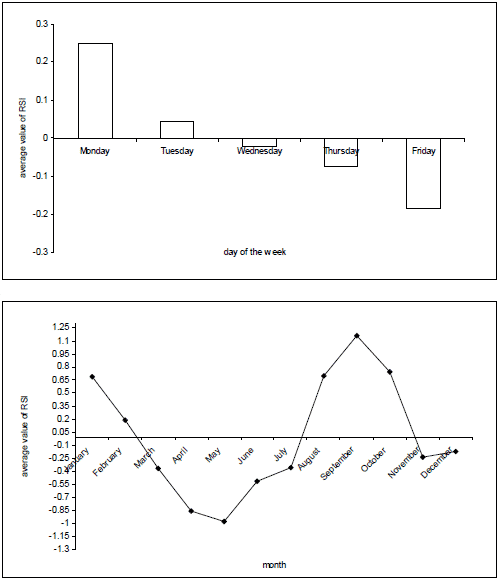Does the Chicago Board Options Exchange Volatility Index (VIX) have separable components of rational and irrational risk? If so, is the irrational risk component of use to investors? In their October 2009 paper entitled “Risk Sentiment Index (RSI) and Market Anomalies”, Guy Kaplanski and Haim Levy introduce the Risk Sentiment Index (RSI) as a measure of the residual risk contained in VIX after accounting for the statistical and economic variables most predictive of future stock market volatility (such as previous month actual volatility and VIX). They also analyze factors which affect RSI and its relationships with day-of-the-week and month-of-the-year stock market anomalies. Using daily closes for VIX and the S&P 500 Index during 1990-2007 (4,538 days) and for the Volatility Index Japan (VXJ) and the Nikkei 225 Index during 1995-2007 (3,200 days), they conclude that:
- The coincident correlation between RSI and actual stock market returns is negative (-0.29 for daily U.S. data).
- RSI varies significantly on average by: (1) day of the week, peaking on Monday and declining consistently through Friday; and (2) season of the year, peaking in August-October. (See the charts below.)
- Evidence supports a Seasonal Affective Disorder (SAD) explanation for RSI seasonality.
- In the past, both the day-of-the-week and the seasonality anomalies affected actual returns. However, professional (unsentimental) investors appear to have eliminated the former and weakened the latter in recent years.
- Still, the persistent negative correlation between RSI and stock market returns implies that there may be conditions with high RSI and relatively low returns either unknown or unexploited by professional investors.
- Although RSIs for the Japanese and U.S. stock markets are uncorrelated, day-of-the-week and seasonality effects also exist in the Japanese market.
The following charts, taken from the paper, depict the average values of RSI by day of the week (upper chart) and by calendar month (lower chart) based on data for the U.S. stock market over the period 1990-2007. Calendar month results are based on monthly averages for RSI. The upper chart shows that average RSI peaks on Monday and decreases systematically during the week, with average values for Wednesday, Thursday and Friday negative. The lower chart shows that RSI on average tends to peak during August-October, perhaps explaining the relatively poor performance of U.S. stocks during those months.

In summary, evidence suggests that: (1) VIX may contain an extractable component of irrationally felt risk negatively related to stock returns; and, (2) rational investors may not have fully exploited this relationship.
Note that the study focuses on the coincident relationship between RSI and stock market returns. Predicting future returns based on RSI for unexploited conditions requires either relating RSI to future returns or predicting RSI.
A reader commented (with responses in brackets and indented):
1. I wish academics wouldn’t redefine a commonly used acronym (RSI=Relative Strength Index).
[It is annoying that the authors re-use an acronym commonly used for something else by many investors.]
2. What does it mean in plain English? What I think it is saying is that implied volatility is sometimes too high and sometimes too low and that this varies by day of the week and season.
[The authors are saying that there are rational (predictable with statistical analysis of historical data) and emotional (perhaps predictable based on human nature) components to options-implied volatility. The emotional component helps explain, in a coincident relationship, some stock market return anomalies.]
3. How is this exploitable? The logic would be that you should sell volatility premium (e.g. write straddles) when the RSI is high and buy volatility premium when it is low.
[Per the comment at the end of the blog entry, “…the study focuses on the coincident relationship between RSI and stock market returns. Predicting future returns based on RSI for unexploited conditions requires either relating RSI to future returns or predicting RSI.” Persistence of the day-of-the-week and seasonal RSI patterns amount to predictions of RSI and therefore stock market returns. The day-of-the-week prediction fails because (the authors suppose) rational players have identified and extinguished it. There may be other predictable RSI behaviors/patterns. There may be a useful relationship between RSI and future returns.
Investors may be able to estimate RSI crudely by relating current VIX to (1) past VIX and (2) past realized volatility to identify times when people are irrationally pessimistic (high RSI, irrationally high volatility and low prices) and irrationally optimistic (low RSI, irrationally low volatility and high prices).
An interesting interpretation of the study (and the other one referenced) is that only part of VIX deserves status as a “fear index” and that there may be ways to extract the degree of market irrationality from VIX. RSI could be a proxy for that degree.]